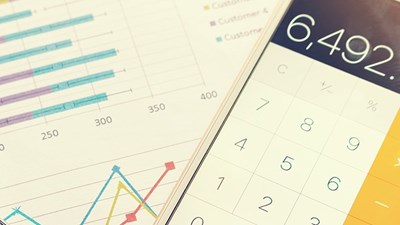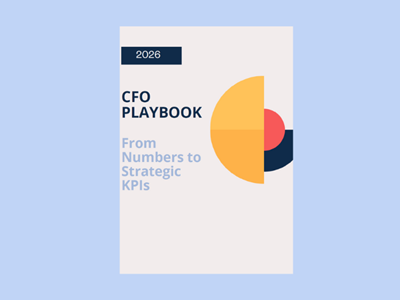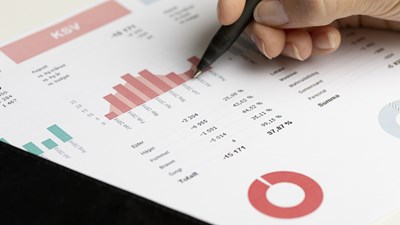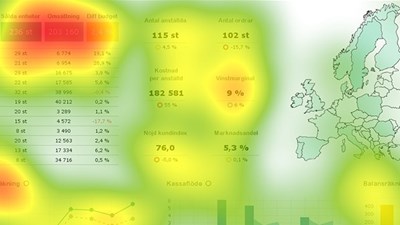
Variance Analysis: A Comprehensive Guide
In business, even small deviations from the plan can have a big impact. Understanding why performance differs from expectations is key to staying in control. That’s where variance analysis comes in as a fundamental tool in management accounting that compares planned financial outcomes with actual results.
Variance analysis helps organisations gain actionable insights into operational efficiency, cost control, and strategic decision-making. In this guide, we'll explore its principles, applications and calculations to empower businesses in optimising financial health.
What Is Variance Analysis?
Variance analysis examines deviations between budgeted and actual figures across revenue, costs or operational metrics. It is used to transform raw data into actionable intelligence by categorising variances as favourable (actual performance better than expected) or unfavourable (worse than expected). For instance, if raw material costs exceed projections due to supplier price hikes, this unfavourable variance prompts supply chain reviews.
If we go beyond problem identification, we'll see that it drives continuous improvement by highlighting efficiency gaps and validating forecasting models.
The Role of Variance Analysis in Performance Management
Most businesses perform variance analysis on a periodic basis: monthly, quarterly or annually. This is done in enough detail to allow managers to understand what's happening to the business while not overburdening staff. However, by the time the information is produced, it is already out of date.
Using a software solution helps businesses meet the demands of decision makers in a more timely way. Real-time, detailed variance analysis is now possible with technology solutions, and the right solution should enable finance to do more than simply present the numbers to the board.
Mercur's performance management platform automates variance tracking, linking discrepancies to specific departments or activities for accountability. This granular visibility helps managers:
Identify inefficiencies (e.g., production delays inflating labour costs)
Reward outperformance (e.g., sales teams exceeding targets)
Refine future budgets using historical variance patterns
For dynamic performance optimisation, explore Mercur’s performance management solutions, which transform variance data into strategic adjustments.
Types of Variances
Variance comes to life when applied to real-world business scenarios. Examining specific cases allows organisations to see how differences between planned and actual results reveal important insights.
This is the reason businesses need to understand the different types of analysis, which shed light on a specific aspect of an organisation's financial performance. Breaking them down into categories means businesses can pinpoint exactly where results deviate from expectations and why. The foundation for meaningful budget variance analysis and improved decision-making is knowing the types of variances.
Purchase Variance Analysis
Also known as purchase price variance (PPV), it deals with the difference between the actual price for goods and the standard or budgeted price. It helps businesses to measure procurement efficiency and understand cost discrepancies in purchasing. Businesses can also use it to identify areas for improvement in procurement. Let's see this with an example:
Suppose a company budgeted to purchase 1,000 units of a component at a standard price of £8 per unit. However, due to market fluctuations, the actual price paid was £9 per unit.
We calculate using the following formula:
PPV=(Actual Price−Standard Price)×Quantity Purchased
PPV = (£9 − £8) × 1,000 = £1 × 1,000 = £1,000 (unfavourable)
This means the company spent £1,000 more than expected on purchasing these components, resulting in an unfavourable purchase price variance. A favourable PPV occurs if bulk negotiations reduce per-unit costs below budget. So, let's say the same company managed a successful negotiation, where the actual price paid was only £7.50 per unit.
PPV = (£7.50 − £8.00) × 1,000 = (−£0.50) × 1,000 = −£500 (favourable)
This means the company spent £500 less than expected on purchasing these components, resulting in a favourable purchase price variance.
Sales Variance Analysis
The sales variance analysis examines the difference between the budgeted or forecasted sales and the actual sales. It's used to understand the reasons for the discrepancy and find ways to improve them.
Let's see how this works if we use an example. Suppose a company budgeted to sell 4,000 units of a product at a standard price of £25 per unit. In reality, the company sold 4,500 units at an actual price of £23 per unit.
Sales Volume Variance=(Actual Units Sold−Budgeted Units)×Standard Price (4,500−4,000)×£25=500×£25=£12,500 (favourable)
Sales Price Variance=(Actual Price−Standard Price)×Actual Units Sold (£23−£25)×4,500=(−£2)×4,500=−£9,000 (unfavourable)
The company sold 500 more units than expected, resulting in a £12,500 favourable volume variance. However, the lower selling price of £23 instead of £25 caused a £9,000 unfavourable price variance. Overall, the net effect on revenue is a £3,500 favourable variance.
Overhead Variance Analysis
This process is used by businesses to understand whether they manage their resources well. It's also used for pricing products or services and controlling costs.
For instance, a company budgets £30,000 for overhead costs in a given month, which includes expenses such as utilities, rent and maintenance. At the end of the month, the actual overhead costs total £33,500.
Overhead Variance=Actual Overhead−Budgeted Overhead
Overhead Variance = £33,500 − £30,000 = £3,500 (unfavourable)
The company spent £3,500 more on overhead than planned. This unfavourable variance might prompt management to investigate causes such as unexpected repairs, higher utility bills or inefficient resource use. It requires taking corrective actions to control overhead costs in future periods.
How about if the actual overhead costs come to £27,000?
Overhead Variance = £27,000 − £30,000 = −£3,000 (favourable)
In this case, the company spent £3,000 less than expected on overhead costs. This could be a result of energy-saving initiatives, negotiated lower rent or efficient maintenance scheduling. It reflects effective cost control.
Material Variance Analysis
The formula used in this analysis will help those businesses that wish to find out where they are using more materials than they actually need. It's a way for businesses to decide whether they should look for a new material supplier or continue with the existing one. Excessive usage variance may indicate wasteful production practices.
For example, a bakery sets a standard cost for flour at £0.80 per kilogram and expects to use 1,000 kg for the month. During the month, the bakery actually purchases 1,100 kg of flour but manages to pay only £0.75 per kilogram. The actual quantity of flour used is 950 kg, which is less than the standard quantity expected.
Material Price Variance=(Actual Price−Standard Price)×Actual Quantity (£0.75−£0.80)×1,100=(−£0.05)×1,100=−£55 (favourable)
Material Usage Variance=(Actual Quantity Used−Standard Quantity)×Standard Price (950−1,000)×£0.80=(−50)×£0.80=−£40 (favourable)
The bakery saved £55 by purchasing flour at a lower price than expected and saved £40 by using less flour than the standard allowance. Both variances are favourable, indicating effective cost control in purchasing and usage.
Now, let's see an unfavourable scenario. A furniture manufacturer sets a standard cost for wood at £12 per board foot and expects to use 5,000 board feet for production. However, during the month, the manufacturer purchases 5,200 board feet at £13 per board foot. The actual quantity of wood used is 5,300 board feet, exceeding the standard quantity.
(£13−£12)×5,200=£1×5,200=£5,200 (unfavourable)
(5,300−5,000)×£12=300×£12=£3,600 (unfavourable)
The manufacturer incurred £5,200 extra cost due to paying a higher price for wood and £3,600 more due to using more wood than planned. Both variances are unfavourable, signalling issues in procurement pricing and production efficiency.
Labour Variance Analysis
The formulas below are used to assess workforce cost-efficiency. So, for instance, a company sets a standard labour rate of £15 per hour and expects 1,200 hours to complete a job. However, the actual labour rate paid is £14 per hour, and the actual hours worked are 1,100.
Labor Rate Variance=(Actual Rate−Standard Rate)×Actual Hours
(£14−£15)×1,100=(−£1)×1,100=−£1,100(favourable)
Labor Efficiency Variance=(Actual Hours−Standard Hours)×Standard Rate
(1,100−1,200)×£15=(−100)×£15=−£1,500(favourable)
The company paid £1,100 less per hour than expected and used 100 fewer hours than budgeted, saving £1,500 in labour time. Both variances are favourable, indicating efficient labour cost management and productivity.
Unfavourable efficiency variance often points to training gaps or outdated workflows. So, if a manufacturing firm budgets a standard labour rate of £20 per hour and expects 800 hours for production. In reality, the actual labour rate is £22 per hour, and the actual hours worked are 900.
(£22−£20)×900=£2×900=£1,800(unfavourable)
(900−800)×£20=100×£20=£2,000(unfavourable)
This means that the company paid £1,800 more due to a higher wage rate and spent 100 extra hours, costing an additional £2,000.
Efficiency Variance Analysis
Measures resource productivity beyond labour, like machine output per hour. Let's say a furniture manufacturer budgets to produce 1,000 chairs in a month. The standard cost to produce each chair is £50. Based on production plans, the standard output expected by this point in the month is 1,000 chairs. However, the actual output achieved is 1,100 chairs.
Efficiency Variance = (Actual Output − Standard Output) × Standard Cost per Unit
(1,100 − 1,000) × £50 = 100 × £50 = £5,000 (favourable)
The manufacturer produced 100 more chairs than planned at the standard cost per unit, resulting in a £5,000 favourable efficiency variance. This indicates better-than-expected productivity, as more output was achieved without increasing the standard cost per unit. Such a variance suggests effective use of resources and operational efficiency.
If the actual output had been less than the standard output, the variance would be unfavourable, signalling inefficiencies or production issues needing attention.
How To Automate Variance Analysis with Mercur
Mercur Business Control can become your organisation's primary tool for analysis and meets all your requirements for fixed and flexible reports, and dynamic analysis.
Mercur Solutions has developed and delivered advanced and high-quality solutions for planning, reporting and analysis for over 40 years. Its corporate performance management and business intelligence software can support different technical environments and very diverse requirements for customers across the globe.
Would you like to know more?
You may also be interested in
 Blog
BlogWhat Is FP&A? Definition, Purpose, and Best Practices
Without solid financial planning and analysis (FP&A), businesses operate in the dark. In this post we go deeper into the process of FP&A and why it’s important for businesses.
 Blog
BlogHow to succeed with your planning, budgeting, and forecasting process
We know it can be challenging to succeed with your planning, budgeting, and forecasting process. Therefore, we have gathered our best tips for you to succeed!
 Blog
BlogHow Automated Reporting Will Transform FP&A in 2026
This article highlights the power of report automation, how to implement it in your business and explores any new opportunities for accurate financial analysis in the long run.
 Blog
BlogA practcial guide to scenario planning
Scenario planning gives you a clear, practical way to test assumptions, spot risks and opportunities, and make better strategic choices so your organisation stays resilient when conditions change.
 Blog
BlogManagement Reporting Guide: Definition and Tips
Management reporting helps you see what’s really happening in your business. In this guide, we’ll explain what managerial reporting looks like and share practical tips.
 Blog
BlogSpreadsheets Risk the Future of the Business
Spreadsheets often start as just a list for storing information and there is minimal process documentation, support or maintenance for these worksheets. Despite the fact that desktop applications such as Microsoft Office are included in the standard configuration of users' PCs, very little formal training is ever given to spreadsheet users.
 Blog
BlogThe Collaborative, Smarter Budget
In many organisations manual budgeting processes over-burden staff and create masses of data which overwhelms department heads and stops them seeing the bigger picture.
 Blog
BlogBudgeting in a modern world
Thirty years after its debut, Microsoft Excel is still the preferred tool for budgeting and planning projects. However, its popularity is declining, due in most part to the rise of technology and subscription-based pricing for a myriad of SaaS-based products.
 Blog
BlogWhat is management reporting?
Management Reporting refers to the process of creating, analyzing, and presenting information about various aspects of an organization's performance to enable decision-makers to make well-informed decisions about the future.
 Blog
BlogBusiness Intelligence Reporting For Finance Teams
The real challenge today isn’t collecting data, it’s making sense of it and fast. Organisations turn to business intelligence (BI) to convert raw data into insight.But how do you actually do it right?
 Blog
BlogWhat Is Planning, Budgeting and Forecasting?
Planning, budgeting and forecasting are rarely static. Shifts in the industry often require you to revisit assumptions, adjust targets and adopt new processes. Learn how to strengthen your approach and stay ahead of change.
 Blog
BlogCFO Playbook - KPIs for 2026
The role of the CFO is changing fast. Today, the finance function is expected to deliver more than reports — it must drive direction, speed and profitability through clear, actionable KPIs. Learn more in this guide.
 Blog
BlogWhat is Corporate Performance Management? (CPM)
CPM, or Corporate Performance Management, is a process within corporate management aimed at measuring and optimizing the performance of an organization. CPM encompasses a range of activities, including budgeting, planning, forecasting, reporting, and analysis.
 Blog
BlogRisks with working in spreadsheets
Spreadsheets are an essential tool for all types of organisations and businesses rely on them heavily, particularly for financial computations. The most popular spreadsheet program globally is, of course, Microsoft Excel, it’s used by an estimated 750 million people.
 Blog
BlogBetter Revenue Planning
Sales forecasting is the process of predicting future revenue based on past data and trends. Read the blog to learn the best methods to do it right.
 Blog
BlogInformed Business Decisions at Maximum Velocity
The ability to process information swiftly is essential. If your business can’t manage your data efficiently, your company’s financial performance will surely underperform. At Mercur we have developed our own database Veloxic which helps Financial Planning and Analysis.
 Blog
BlogWhy xP&A is a powerful game-changer
The newest iteration of planning, analysis and reporting systems is a powerful game-changer that unites company departments and boosts competitiveness. It’s called xP&A – the abbreviation of extended financial planning and analysis.
 Blog
BlogCash Flow Forecasting
Inaccurate cash flow forecasting can be a costly mistake for companies. In today’s volatile market, relying on static annual budgets or manual spreadsheets leaves financial leaders without the agility to respond to uncertainty.
 Blog
BlogBoost Report Readability, Engagement, and Decision-Making
In today’s fast-paced business environment, effective reports and dashboards are crucial for decision-making. Our user study using eye-tracking technology revealed seven key insights into what captures attention.
 Blog
BlogRolling Forecasts: Practical Steps, Benefits, and How to Get Started
Financial planning has changed. Traditional annual budgets can’t keep up with rapid shifts in the market, evolving customer needs, and internal performance dynamics. That’s why many finance teams are turning to a rolling forecast model.
 Blog
BlogBusiness Budgeting Software: How to Choose the Right One
Choosing budgeting software is partly a finance and partly a strategic decision. The right tool helps organisations organise planning cycles, adapt as the market changes and increase accountability across departments. But not every platform will be a good fit.
 Blog
BlogFive tips for a successful budget process!
How can you make your budget process more successful and maximise the effort that was invested in creating it? Of course, there are many factors to consider but we’ve chosen to highlight five key areas that will enable and help you create a smoother, value-creating and collaborative budget process.
 Blog
BlogSpreadsheet Risk Management: Best Practices for 2025
Excel has long been a target for hackers; just one click on a malicious attachment can infect your entire network. So, how can you keep using spreadsheets while not sacrificing your safety?
 Blog
BlogAI in Finance as a Powerful Tool
In this post, we explore how AI is evolving from a theoretical concept into a valuable resource for decision-making. Get useful insights for finance teams at any stage, from early exploration to actively using AI-powered solutions.
 Blog
BlogThe Powerhouse of EPM Tools
A business’s success heavily relies on having a strong strategy. However, what's even more important is implementing that strategy while tracking and measuring the performance. This can easily be done by investing in enterprise performance management (EPM) software.
 Blog
BlogHow to Effectively Budget with Driver-Based Forecasting
Traditional models of forecasting rely on historical data and beliefs. It uses techniques that identify patterns, which are simple to use. However, with these methods, there are some challenges because they are not dynamic with today’s market, and can’t effectively analyse complex data.
 Blog
BlogTop 7 Manager KPIs for Financial and Operational Success
In today's post we'll break down why KPIs matter, which ones offer the most insight for finance and executive teams and how to ensure they're actually driving results.
 Blog
BlogThe Business Benefits of Integrated Business Planning
This blog explores what IBP is and the typical IBP process. We highlight business benefits and how the right software can be a game-changer for your organisation.
 Blog
BlogSave time and create a successful budget process
If you’re working in a large organization, you’re probably aware of how time-consuming the budget process can be. In this article we’ll give you tips on how to save time and still create a successful budget process
 Blog
BlogHow to get accurate financial reports without waiting for month-end
You don't need to wait until month-end to see accurate financial reports. With modern financial systems you can access up-to-date reports whenever you need them.
 Blog
BlogAI in Financial Planning: Trends and Next Steps
Discover how finance teams are using AI to drive smarter planning, faster insights, and stronger business decisions.
 Blog
BlogAI in corporate budgeting
Artificial Intelligence (AI) can support decision making in key areas such as budgeting, capital allocation and even corporate strategy and as a result, it is increasingly being deployed in corporate performance management tools (CPM).
 Blog
BlogScenario Planning - Better control during uncertain times
Uncertain times create the need for more frequent forecasts and time for analyzing and comparing different future scenarios. We give you 5 tips on how to simulate future scenarios using scenario planning
 Blog
BlogAI and Machine Learning, what is it, and why is it important for the future?
Artificial Intelligence and Machine Learning, what is it, and what is the difference?
 Blog
BlogFrom static budgets to agile financial management
Traditional budgeting has long been the cornerstone of financial planning in businesses. But today it can become more of a limitation than a strength. That’s where the concept of Beyond Budgeting comes in.
 Blog
BlogFP&A Trends Shaping Financial Planning in 2025
Many organisations cope with fragmented planning and data quality issues, which slow down their forecasting cycles. This forces organisations to take practical steps to turn ambition into execution.
 Blog
BlogThe Role of the CFO: Top Priorities and Responsibilities
Today's finance leaders steer more than just budgets and reports. The digital transformation ramps up with the increase of corporate complexity, and so does the role of CFOs.
 Blog
Blog3‑Statement Model for Better Financial Forecasting
Financial forecasting is critical for any business that wants to adapt to change. But finance teams keep usingfragmented models and manual processes. The 3-statement financial model is the solution.
 Blog
BlogBest Guide to Improve Your Revenue with Flexible Budgeting
Optimise your expenses with flexible budgeting, and learn how to adjust budget to reflect current business activities, market changes and cost fluctuations.
 Blog
BlogBuild Long-Range Planning for Business Success
Discover how effective long-range planning aligns strategy, finance and operations for smarter decisions and sustainable growth.
 Blog
BlogZero-Based vs. Incremental Budgeting
Budgeting sits at the heart of sound financial management. This is why choosing the right technique is crucial for CFOs – it shapes resource allocation, cost control and strategic agility. Incremental and zero-based budgeting are two leading methods that offer distinct approaches.
 Blog
BlogBalancing Profitability and Sustainability
Sustainability has become a central concern for organisations across the world — and the UK is no exception. This evolving landscape places new demands on financial reporting.
 Blog
BlogWhy is our Excel-based budget always out of date?
Excel creates outdated budgets. Every time someone enters a figure, sends a file, or waits for another department to finish their section, your budget falls further behind reality.
 Blog
BlogMastering Spreadsheets
Where many businesses start small, a simple spreadsheet can adequately perform the limited tasks required of it. As the company grows, your spreadsheets can get more complex and harder to manage, by which point it feels like it will be too difficult to move to a different reporting tool.
 Blog
BlogHow EPM Transforms Financial Planning and Forecasting
Struggling to keep plans aligned in a changing market? Discover how EPM helps finance teams move faster, stay accurate and lead with real-time insights.
 Blog
BlogSpreadsheets are not Collaborative Tools
Spreadsheets were never designed for collaboration, yet they are the single most used program among teams and co-workers. They often start out as a quick document for storing, formatting or calculating information but evolve into important documents and are often the core records for an organisation.
 Blog
BlogHow do finance teams track KPIs across the entire organisation?
Learn how finance teams track KPIs across the entire organisation by consolidating data from multiple sources into a unified system like Mercur.
 Blog
BlogTop PowerBI Alternatives in 2025
Explore the top PowerBI alternatives for 2025. Discover how Mercur delivers integrated planning, budgeting and reporting without the high cost and complexity.
 Blog
BlogThe Hidden Cost of Data Silos
If you ever feel like your teams speak different languages when it comes to data, it is a classic symptom of data silos. The information gets stuck in one department, system or tool, making it difficult for anyone to see the full picture.
 Blog
BlogHow To Create a Successful Budgeting Process
When done well, budgeting helps organisations stay financially on course, even when things don’t go exactly as planned. Learn how to keep things on track so you avoid surprises and stay focused on your goals.
 Blog
BlogHow can AI help CFOs make better decisions?
Artificial Intelligence (AI) has significant potential to enhance decision-making for Chief Financial Officers (CFOs) by providing data-driven insights, automating routine tasks, and enabling more accurate forecasts.
 Blog
BlogTop-Down vs Bottom-Up Budgeting
Budgeting aligns resources with strategic goals, and there are two primary approaches: top-down and bottom-up. Which method wroks best?



















































